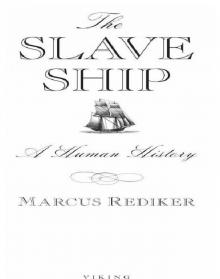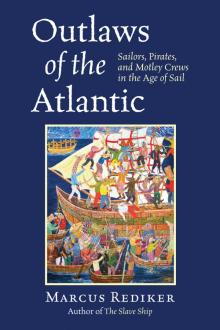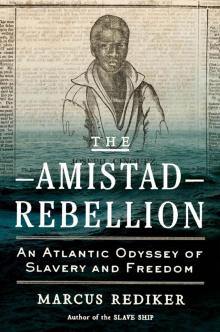- Home
- Marcus Rediker
The Amistad Rebellion
The Amistad Rebellion Read online
The Amistad Rebellion
ALSO BY MARCUS REDIKER
The Slave Ship: A Human History
Villains of All Nations: Atlantic Pirates in the Golden Age
The Many-Headed Hydra: Sailors, Slaves, Commoners, and the
Hidden History of the Revolutionary Atlantic
(with Peter Linebaugh)
Who Built America? Working People and the Nation’s Economy,
Politics, Culture, and Society, Volume One: From Conquest and
Colonization Through Reconstruction and the Great Uprising of 1877
(with the American Social History Project)
Between the Devil and the Deep Blue Sea: Merchant Seamen, Pirates,
and the Anglo-American Maritime World, 1700–1750
The Amistad Rebellion
AN ATLANTIC ODYSSEY OF SLAVERY AND FREEDOM
Marcus Rediker
VIKING
VIKING
Published by the Penguin Group
Penguin Group (USA) Inc., 375 Hudson Street, New York, New York 10014, U.S.A. • Penguin Group (Canada), 90 Eglinton Avenue East, Suite 700, Toronto, Ontario, Canada M4P 2Y3 (a division of Pearson Penguin Canada Inc.) • Penguin Books Ltd, 80 Strand, London WC2R 0RL, England • Penguin Ireland, 25 St. Stephen’s Green, Dublin 2, Ireland (a division of Penguin Books Ltd) • Penguin Books Australia Ltd, 250 Camberwell Road, Camberwell, Victoria 3124, Australia (a division of Pearson Australia Group Pty Ltd) • Penguin Books India Pvt Ltd, 11 Community Centre, Panchsheel Park, New Delhi—110 017, India • Penguin Group (NZ), 67 Apollo Drive, Rosedale, Auckland 0632, New Zealand (a division of Pearson New Zealand Ltd) • Penguin Books (South Africa) (Pty) Ltd, 24 Sturdee Avenue, Rosebank, Johannesburg 2196, South Africa
Penguin Books Ltd, Registered Offices: 80 Strand, London WC2R 0RL, England
First published in 2012 by Viking Penguin, a member of Penguin Group (USA) Inc.
10 9 8 7 6 5 4 3 2 1
Copyright © Marcus Rediker, 2012
All rights reserved
Illustration credits appear on pages 287–88.
LIBRARY OF CONGRESS CATALOGING IN PUBLICATION DATA
Rediker, Marcus.
The Amistad rebellion : an Atlantic odyssey of slavery and freedom / Marcus Rediker.
p. cm.
Includes bibliographical references and index.
ISBN: 978-1-101-60105-1
1. Slave insurrections—United States. 2. Amistad (Schooner) 3. Antislavery movements—United States. 4. Slave trade—America—History. 5. Sierra Leoneans—United States—History—19th century. I. Title.
E447.R44 2012
326.0973—dc23
2012014810
Printed in the United States of America
Designed by Carla Bolte • Set in Adobe Palatino LT Std. with Bodoni Ornaments ITC
No part of this book may be reproduced, scanned, or distributed in any printed or electronic form without permission. Please do not participate in or encourage piracy of copyrighted materials in violation of the author’s rights. Purchase only authorized editions.
ALWAYS LEARNING PEARSON
For Wendy,
with love
CONTENTS
Introduction Voices
One Origins
Two Rebellion
Three Movement
Four Jail
Five “Mendi”
Six Freedom
Conclusion Reverberations
Acknowledgments
Notes
Index
Illustration Sources and Credits
INTRODUCTION
Voices
During the moonless early hours of July 2, 1839, several captive Africans quietly slipped out of their fetters in the hold of the slave schooner La Amistad. One of them had managed to break a padlock, which made it possible to remove the chain that reeved them together and held them down in the hold below the main deck of the vessel. Forty-nine men and four children made up the human cargo of the Amistad. They had sailed from Havana, bound for the new plantations of Puerto Príncipe (Camagüey), Cuba. A few hours earlier, in cramped, airless quarters below deck, they had made a collective decision to seek a different fate.
A group of four men—Cinqué, Faquorna, Moru, and Kimbo—led the way as they climbed up and out of the hatchway onto the main deck. They moved with the grace and precision of warriors accustomed to daring midnight attacks. They picked up belaying pins and barrel staves and stole over to the ship’s boat, where the mulatto cook and slave sailor Celestino lay sleeping. They bludgeoned him to death. As more men escaped their irons and swarmed up on deck, they opened a box of cane knives, tools they were meant to use in cutting sugar cane, but which would now serve the purpose of self-emancipation. The sight of flashing blades caused the two sailors who were supposed to guard against such uprisings to fly over the side of the vessel into the water. Captain Ramón Ferrer armed himself and fought back against the insurgents, killing one and mortally wounding another. Four or five of their comrades counterattacked, surrounding the captain and slashing him to death.
In a matter of minutes the Amistad rebels had turned the ship’s wooden world upside down. They captured the two men who had considered themselves their owners, José Ruiz and Pedro Montes, clapped them in manacles, and sent them below deck as their prisoners. They took control of the ship and organized themselves to do the hard work of sailing it. But in their new-won freedom lay a dilemma: they wanted to return to their homes in southern Sierra Leone, but none of them knew how to navigate the schooner. After some debate they decided to keep the surviving Spaniards alive in order to help them sail the vessel eastward, toward the rising sun, which had been at their backs as they made the Middle Passage on a slave ship two weeks earlier.
Montes had been a merchant ship captain; he was experienced in the ways of the sea and shrewd in the ways of men. He used his specialized knowledge of the deep-sea sailing ship to deceive his new masters. During the day, he followed orders, sailing east, but he had the sails kept loose and flapping in the wind to slow the Amistad’s progress. By night he steered the vessel back to the west and the north, hoping to stay near the islands of the Caribbean and the coast of North America in order to be intercepted and saved. After eight weeks, he got his wish: a U.S. Navy survey ship captured the Amistad off Culloden Point, Long Island, and carried the Africans, the Spaniards, the cargo, and the schooner to New London, Connecticut.
What would happen to these African rebels now anchored in one of the world’s leading slave societies? Would they be returned to Cuba to be tried—and certainly executed—for their crimes of mutiny, murder, and piracy, as the diplomats of Spain, and many American slaveholders, demanded? Or would they, as Lewis Tappan and other abolitionists on both sides of the Atlantic insisted, in the aftermath of the abolition of the slave trade, be allowed to go free? Had they not defended their own natural rights by killing the tyrant who enslaved them? These questions would engage people of all stations and several nations in fierce debate, propelling the Amistad rebels to the center of a massive controversy about slavery and the rights of unfree people to shape their own destiny. The rebellion became one of the most important events of its time.
An epic struggle ensued. Assisted in their legal battles by distinguished attorneys Roger S. Baldwin and former president John Quincy Adams, who made dramatic speeches before the United States Supreme Court in February and March 1841, the Amistad rebels won their freedom, to the joy of half the nation and the consternation of the other half. After a successful fund-raising tour organized by abolitionists, the rebels set sail for their African homelands in November of that year. The abolitionist movement claimed a great, historic, and altogether unlikely victory.
> The popular memory of the Amistad rebellion has ebbed and flowed with the political tides. In its own day the event captured the popular imagination. A mere six days after the vessel had been towed into port, a drama troupe at New York’s Bowery Theatre performed a play about its story of mutiny and piracy. Commercial artists converged on the jail where the Amistad Africans were incarcerated, drew images of Cinqué, the leader of the rebellion, reproduced them quickly and cheaply, and had them hawked by boys on the streets of eastern cities. Artist Amasa Hewins would paint a 135-foot panorama depicting the Amistad Africans as they surrounded and killed Captain Ferrer and seized their freedom by force of arms. Another artist, Sidney Moulthrop, would create twenty-nine life-size wax figures of the Africans and the Amistad crew, cast and arranged to dramatize the shipboard insurrection. Both artists would tour with their creations, charging admission to those eager to see a visual reenactment of the uprising. Meantime, thousands of people lined up daily to pay admission and walk through the jails of New Haven and Hartford to get a glimpse of the Amistad rebels, who were “political prisoners” before the phrase had been invented. When the case moved to law, citizens jammed the courtrooms to capacity and beyond, refusing to leave their seats during breaks for fear of losing them. Ministers delivered thundering sermons; correspondents wrote hundreds of highly opinionated newspaper articles; poets penned romantic verses; and those for and against slavery debated furiously, all about the Amistad rebels, what they had done, its morality and meaning, and what their fate should be. Discussed in public as never before, slave resistance became not only a main political issue of the day, but a commercial entertainment—a commodity that circulated in the ever-growing American marketplace, shaping public opinion and ultimately the outcome of the case.
The fascination would not last. After the Civil War the memory of the Amistad waned, barely kept alive by two related groups: abolitionists and African American writers and artists who wanted to glory in victory and remember the long, arduous struggle against slavery. In the dark times of Social Darwinism and scientific racism the Amistad uprising faded from public view. It disappeared from histories of the United States written in the late nineteenth and early twentieth centuries, and indeed it saw no major revival until new social movements exploded in the 1960s and 1970s. Especially important in this regard were the civil rights and black power movements with their demands for a new history of the United States that took seriously the long, bloody battle against slavery and racism. The Mississippi Freedom Summer Schools taught about the Amistad rebellion, while activists named their sons Cinqué after its heroic leader. “History from below” raised the consciousness of struggles past and present, and post-’60s historians made the Amistad story part of a new, more democratic and inclusive vision of the American past. Yet knowledge of the shipboard insurrection among the general public remained limited.1
A new phase in popular memory and culture began in 1997 with the appearance of Steven Spielberg’s movie Amistad, which carried the history to millions of viewers, many of whom had never before known of it. Although not a commercial success, the film had a broad impact, creating a veritable cottage industry around the history of the event: school curricula incorporated the rebellion; children’s coloring books depicted it; museums and art galleries celebrated it; novels, plays, and operas dramatized it. Independent efforts by organizers in Connecticut to fund and re-create the vessel came to fruition after the appearance of Spielberg’s film, resulting in a modern Amistad based in Mystic Seaport.2
The history and especially the movie gave the Amistad insurrection a renewed presence in American popular culture. The rebellion rapidly became one of the best-known events involving slavery in all of American history, and Cinqué joined Underground Railroad “conductor” Harriet Tubman and runaway slave-turned-eloquent-abolitionist Frederick Douglass as the most recognizable individuals of African descent associated with the histories of slavery and resistance in America.3
Yet the history and the movie have told only part of the story. The drama of the courtroom has eclipsed the original drama that transpired on the deck of the slave schooner. The American actors—abolitionists, attorneys, judges, and politicians—have elbowed aside the African ones whose daring actions set the train of events in motion. Curiously, the American legal system has emerged as the story’s hero—the very system which, in 1839, held two and a half million African Americans in bondage. This triumphalism may be comforting to an American audience still haunted by the legacy of slavery, but it is deeply misleading.
This book tells the story of the Amistad in a different way. It begins in southern Sierra Leone, in West Africa, where those who would eventually find themselves aboard the Amistad were, by various means, captured and enslaved, inaugurating an odyssey of epic proportions. These multiethnic people—mostly Mende, but also Temne, Gbandi, Kono, Gola, and Loma—came from humble backgrounds. They were commoners and workers; a few had been slaves. Born of societies that shared commonalities of belief and culture, these West Africans began a long, slow process of social bonding and self-organization, first at the Lomboko slave-trading “factory” on the Gallinas Coast, where they were held for several weeks awaiting Atlantic transport on a slave ship called the Teçora. Under the extreme, terrifying conditions of the Middle Passage they bonded as “shipmates,” cooperating for the sake of survival. The process continued in the barracoons, or slave barracks, of Havana, where they were held and, after two weeks, sold under humiliating circumstances, as if they were cattle. Guided by the practices of a powerful all-male secret society in their homelands called the Poro Society, they organized themselves to carry out the rebellion aboard the Amistad. Under the pressure of necessity they worked together to sail the vessel 1,400 miles from the north coast of Cuba to the northern tip of Long Island; several of their comrades died of dysentery and dehydration along the way. Captured by the United States Navy and charged with piracy and murder, they were incarcerated in New Haven, Connecticut. The maritime leg of the odyssey featured violence, suffering, and self-emancipation.
The rebels now took their drama of slavery and freedom onto an American stage. Once they reached the shores of Connecticut, their courageous revolt inspired profound popular interest among artists, playwrights, actors, theatergoers, journalists and writers, readers, lawyers and judges, politicians, and citizens, but especially among abolitionists, who flocked to the jail in large numbers. The Amistad Africans slowly built an alliance with other antislavery activists as they studied reading, writing, and religion, all the while organizing themselves and developing their own independent African identity as “the Mendi People.” They worked with abolitionists such as Lewis Tappan and political figures such as John Quincy Adams to keep their case before the public and to mount a strong legal defense of the freedom that they had won by arms aboard the Amistad. The small group of African captives who took desperate action on the high seas caused some of the most powerful people in the world to debate the meaning of what they had done, including monarchs (Queen Victoria of Britain and Queen Isabella II of Spain), presidents and former presidents (Adams, Martin Van Buren, and John Tyler), statesmen, high-ranking government officials, and Supreme Court justices, among many others.
The meaning of the rebellion and trials was shaped not only by American political realities but by broader Atlantic ones, for the Amistad had sailed into a huge and historic wave of slave resistance. David Walker’s Appeal…to the Coloured Citizens of the World (1829) had emphasized the continuing relevance to freedom struggles of Toussaint Louverture and the Haitian Revolution. Sailors black and white spread the revolutionary word by smuggling the pamphlet into slave societies. Nat Turner had led a bloody uprising in Southampton County, Virginia, in 1831, and Sam Sharpe had followed with his “Baptist War” in Jamaica in 1831–32. Other revolts, for example, in Brazil and Cuba, erupted against the backdrop of a growing abolitionist movement and indeed helped to make it possible. William Lloyd Garrison founded the Liberator
in 1831 and Great Britain abolished slavery in its West Indian colonies in two stages, in 1834 and 1838.4
Wherever contemporaries debated the meaning of the Amistad rebellion, the ghosts of Walker, Toussaint Louverture, and Turner hovered above their heads. Noticioso de Ambos Mundos, a Spanish-language newspaper published in New York, posed a “delicate question” amid the debate about whether the Amistad rebels should go free: “Let us then see if the [American] Government establishes the principle that it is lawful for a slave to kill his master, because then they can with impunity rise up in Washington, and slay all masters and all members of the Government that allowed slavery.” The broad Atlantic struggle against slavery generated the larger meaning of the Amistad controversy.5
The meeting of African insurrectionists and American reformers in the New Haven jail was an unprecedented and historic moment. The rebels had made a revolution in miniature aboard the ship, which inspired sympathetic coverage in the press, especially the New York Sun, and in turn generated intense fascination among the public. Tappan and other abolitionists responded, struggling to control and direct the enormous popular interest toward their own purposes, building in the process a determined, energetic, interracial defense campaign. Many who supported the Amistad struggle were not, strictly speaking, abolitionists; moreover, they celebrated the heroic insurrection in ways that made moderate abolitionists uneasy. The Africans themselves, through their actions on the vessel and their noble bearing in jail, continued to inspire an unprecedented interest in the fearsome subject of slave revolt. To many, especially African Americans enslaved and free, the Amistad rebels rekindled the radical egalitarian hope of the American Revolution.6

 Villains of All Nations
Villains of All Nations The Slave Ship
The Slave Ship Outlaws of the Atlantic
Outlaws of the Atlantic The Amistad Rebellion
The Amistad Rebellion